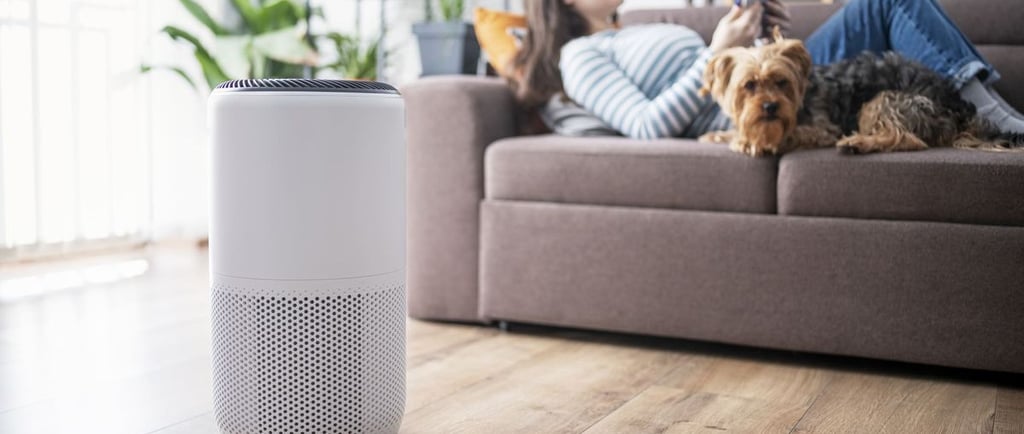How to Select the Best Air Purifier for Your Home
Choosing the right air purifier for your home can significantly improve your indoor air quality, but with so many options on the market, finding the perfect fit can be overwhelming. In this blog, we’ll guide you through the essential factors to consider when selecting an air purifier that meets your specific needs. From understanding different filtration technologies and room size requirements to evaluating features like noise levels, energy efficiency, and maintenance costs, we’ll help you make an informed decision.
Ms. Kei
9/1/20242 min read


How to Select the Best Air Purifier for Your Home
Ensuring clean and healthy indoor air is essential for maintaining overall well-being, especially in today's world where indoor pollutants can affect our respiratory health. An air purifier can be a valuable investment in creating a cleaner indoor environment by removing allergens, dust, pet dander, and other particles from the air. However, with various types and features available, choosing the right air purifier for your home can be daunting. Here’s a comprehensive guide to help you select the best air purifier to meet your needs:
1. Identify Your Air Quality Needs Before selecting an air purifier, assess your specific indoor air quality concerns. Do you primarily want to remove allergens like pollen and dust mites? Are you concerned about odors or volatile organic compounds (VOCs) from household products? Identifying your priorities will help you narrow down the type of air purifier that best suits your needs.
2. Consider the Room Size Air purifiers are designed to clean the air within a specific square footage range. Measure the dimensions of the room where you intend to place the air purifier. Look for a model that is recommended for that room size to ensure optimal performance. Oversized purifiers may consume unnecessary energy, while undersized ones may not effectively clean the air.
3. Choose the Right Filter Type Air purifiers typically use different types of filters to capture particles and pollutants from the air. Here are some common filter types:
HEPA Filters: High-Efficiency Particulate Air (HEPA) filters are highly effective at capturing airborne particles as small as 0.3 microns, including pollen, dust, and pet dander. They are recommended for allergy sufferers and anyone wanting cleaner air.
Activated Carbon Filters: These filters are excellent for removing odors, smoke, and VOCs from the air by absorbing gases and chemicals. If you're concerned about household odors or chemical pollutants, consider an air purifier with an activated carbon filter.
Pre-filters: Pre-filters capture larger particles like hair and dust, extending the lifespan of HEPA and carbon filters. They are typically washable or replaceable and help improve the overall efficiency of the air purifier.
4. Consider Additional Features Modern air purifiers come with a variety of features to enhance convenience and effectiveness:
Air Quality Sensors: Some purifiers have sensors that monitor the air quality in real-time and adjust fan speed accordingly.
Timer and Scheduler: These features allow you to set specific operating times or schedules for the purifier to conserve energy and ensure continuous air cleaning.
Noise Levels: Consider the noise output of the air purifier, especially if you plan to use it in bedrooms or quiet spaces. Look for models with quieter operation settings for nighttime use.
5. Energy Efficiency Check the energy efficiency rating of the air purifier. Energy-efficient models can help reduce electricity costs over time, especially if you plan to run the purifier continuously.
6. Maintenance Requirements Understand the maintenance requirements of the air purifier, including how often filters need to be replaced or cleaned. Factor in ongoing maintenance costs when budgeting for your purchase.
7. Read Reviews and Compare Brands Research different brands and read customer reviews to get insights into the performance, durability, and customer support of various air purifier models. Websites like Consumer Reports and Amazon reviews can provide valuable feedback from users.
Conclusion Choosing the best air purifier for your home involves considering factors such as your specific air quality needs, room size, filter type, additional features, energy efficiency, and maintenance requirements. By understanding these factors and conducting thorough research, you can select an air purifier that effectively improves indoor air quality, creating a healthier and more comfortable environment for you and your family.
3.5
